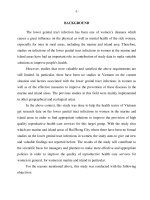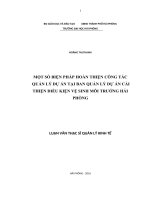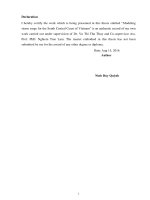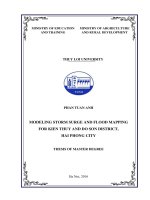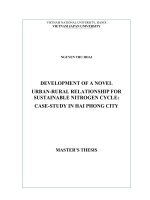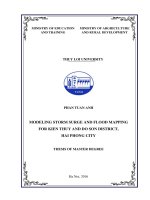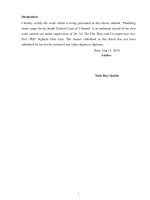Modeling storm surge and flood mapping for kien thuy and do son district hai phong city
Bạn đang xem bản rút gọn của tài liệu. Xem và tải ngay bản đầy đủ của tài liệu tại đây (4.63 MB, 123 trang )
MINISTRY OF EDUCATION
AND TRAINING
MINISTRY OF ARGRICULTURE
AND RURAL DEVELOPMENT
THUY LOI UNIVERSITY
PHAN TUAN ANH
MODELING STORM SURGE AND FLOOD MAPPING
FOR KIEN THUY AND DO SON DISTRICT,
HAI PHONG CITY
THESIS OF MASTER DEGREE
Ha Noi, 2016
MINISTRY OF EDUCATION
AND TRAINING
MINISTRY OF ARGRICULTURE
AND RURAL DEVELOPMENT
THUY LOI UNIVERSITY
PHAN TUAN ANH
MODELING STORM SURGE AND FLOOD MAPPING
FOR KIEN THUY AND DO SON DISTRICT,
HAI PHONG CITY
Major: Coastal Engineering and Management
Majors code: 62580203
SUPERVISORS: 1. Assoc.Prof.Dr. Tran Thanh Tung
2. Dr. Le Tuan Hai
Declaration
I declare that I have developed and written the enclosed Master Thesis completely by
myself, and have not used sources or means without declaration in the text. Any
thoughts from others or literal quotations are clearly marked. The Master Thesis was
not used in the same or in a similar version to achieve an academic grading or is being
published elsewhere.
Ha Noi, Aug 17, 2016
Author
Phan Tuan Anh
i
Preface
I first thank my parents and my brother for their support throughout not only the past
two years, but throughout my entire life. I am truly grateful for all the opportunities
and support provided by my family at every juncture of my life.
After 20 weeks with my efforts and help of my teachers, colleagues, I have completed
my thesis with the subject “MODELING STORM SURGE AND FLOOD MAPPING
FOR KIEN THUY AND DO SON DISTRICT, HAI PHONG CITY”.
I am thankful for my advisors Assoc. Prof. Dr Tran Thanh Tung and Dr. Le Tuan Hai.
This thesis would never have reached completion without their guidance and
assistance. Assoc. Prof. Dr Tran Thanh Tung provided insightful edits and innovative
approaches that helped shaped parts of this thesis. Finally, Dr. Le Tuan Hai provided
guidance, especially in Mike model, that ensured the result of calculation was
comprehensive and accurate.
I am forever grateful to the Faculty of Marine and Coastal Engineering and Thuy loi
University gave me a meaning course. I had a lot of knowledge and reality experiences
in 02 years study.
I would like to thank Dr. Tang Xuan Tho who helps me collect data and guide me in a
field trip to study area.
Last but not least, I am thankful to my friends and colleagues for their support,
encourage and advices.
I hope you will enjoy reading this thesis.
ii
TABLE OF CONTENT
INTRODUCTION .........................................................................................................1
1. Necessity of research ...............................................................................................1
2. Research objects and Scope ...................................................................................3
3. Research content .....................................................................................................3
4. Approach and methodology ...................................................................................3
CHAPTER 1: OVERVIEWS OF STUDY OF STORM SURGE...................................5
1.1
Overview of study in the world ..........................................................................5
1.2
Overview of study in Viet Nam and Hai Phong ...............................................7
1.3
Overview of research methodology and tools .................................................10
1.4.1
Geographical location, administrative boundaries ....................................12
1.4.2
Topographic characteristics ........................................................................15
1.4.3
Geological and soil characteristics .............................................................16
1.4.4
Meteorology and climate characteristics ....................................................17
1.4.4.1 Thermal mode............................................................................................17
1.4.4.2 Relative Humidity ......................................................................................17
1.4.4.3 Piche Evaporation .....................................................................................18
1.4.4.4 Wind ..........................................................................................................18
1.4.4.5 Storm and tropical depression ..................................................................19
1.4.5
Economical and social characteristics........................................................20
CHAPTER 2: SETUP NUMERICAL MODEL TO SIMULATE STORM
SURGE FOR STUDY AREA .....................................................................................22
2.1
Data collection and Analysis.............................................................................22
2.1.1
Topographical data ......................................................................................22
2.1.2
Hydrodynamic data......................................................................................23
2.1.3
2.2
Storm data .................................................................................................24
Introduction of Mike Model .............................................................................31
2.2.1
General .........................................................................................................31
2.2.2
Theory of Mike 21 model.............................................................................32
2.2.3
Theoretical basis of MIKE 21 Toolbox to calculate tide...........................33
iii
2.2.4 Theoretical basis of MIKE 21 Toolbox to calculate atmospheric field and
wind forcing............................................................................................................... 35
2.3
Setup Model ....................................................................................................... 36
2.3.1
Domain ......................................................................................................... 36
2.3.2
Mesh ............................................................................................................. 38
2.3.3
Bathymetry data ........................................................................................... 39
2.3.4
Boundary...................................................................................................... 40
2.3.5
Setting parameters of big model ................................................................. 41
2.4
Calibration and verification of simulation model .......................................... 43
2.4.2
Verification of storm surge model .............................................................. 45
CHAPTER 3: SIMULATING STORM SURGE ..................................................... 50
3.1
Develop scenarios .............................................................................................. 50
3.4
Develop calculated station ................................................................................ 54
3.5
Result of storm surge simulation ..................................................................... 56
3.5.1
Scenario 1 .................................................................................................... 56
3.5.2
Scenario 2 .................................................................................................... 57
3.5.3
Scenario 3 .................................................................................................... 61
3.6
Analysis results of simulation model ............................................................... 64
CHAPTER 4: FLOODING SIMULATION AND DEVELOP FLOOD MAPPING
DUE TO STORM SURGE OF KIEN THUY AND DO SON DISTRICT ............ 65
4.1
Setup flood model .............................................................................................. 65
4.1.1
Domain and mesh ........................................................................................ 65
4.1.2
Bathymetry data ........................................................................................... 66
4.1.3
Input boundaries ......................................................................................... 67
4.1.4
Infrastructure data ...................................................................................... 69
4.1.5
Setup parameters of flood model ................................................................ 70
4.2
Results of flood model ....................................................................................... 71
4.3
Building flood mapping .................................................................................... 73
4.3.1
Appying GIS software to build flood mapping ........................................... 73
4.3.2
Input data ..................................................................................................... 74
4.3.2.1 Flood depth ............................................................................................... 74
4.3.2.2 Administrative map ................................................................................... 77
iv
4.4
Results of flood mapping ..................................................................................78
CONCLUSION AND RECOMMENDATION.........................................................82
REFERENCES ............................................................................................................85
APPENDIX...................................................................................................................89
v
LIST OF FIGURES
Fig 1.1 Administrative map of Hai Phong city ............................................................. 13
Fig 1.2 Sea dikes 2 is protecting populated areas ......................................................... 15
Fig 1.3 Do Son beach .................................................................................................... 21
Fig 1.4 Exploiting seafood ............................................................................................ 21
Fig 2. 1 Hai Phong city map scale 1:50000................................................................... 22
Fig 2.2 Digital elevation model DEM (30x30m) of study area .................................... 23
Fig 2.3 Distribution of storm’s direction landfall in Hai Phong coast .......................... 30
Fig 2. 4 Module Mike 21FM of Mike Zero .................................................................. 32
Fig 2.5 Domain of big model cover small model.......................................................... 37
Fig 2.6 Domain of small model ..................................................................................... 37
Fig 2.7 Mesh of big model ............................................................................................ 38
Fig 2.8 Mesh of small model ......................................................................................... 39
Fig 2.9 Bathymetry of big model .................................................................................. 39
Fig 2.10 Bathymetry of small model ............................................................................. 40
Fig 2.11 Boundary conditions of big model (03 water boundaries, 01 land boundary) 40
Fig 2.12 Water boundary in North East – Code 2 of big model ................................... 41
Fig 2.13 Comparision of water level in calibration of tidal model ............................... 43
Fig 2.14 Comparision of water level in verification of tidal model .............................. 44
Fig 2.15 Tracking of the typhoon Kalmaegi on 09/2014 .............................................. 46
Fig 2.16 Wind forcing data of storm surge model ........................................................ 48
Fig 2.17 Comparision of water level in verification of storm surge model .................. 48
Fig 3.1 Track of the typhoon Sarah in 1977.................................................................. 51
Fig 3.2 Setup storm surge model (big model) of scenario 1 ......................................... 53
Fig 3.3 Wind forcing of scenario 1 .............................................................................. 54
Fig 3.4 Location map of calculated stations .................................................................. 55
Fig 3.5 Water level map of scenario 1 .......................................................................... 56
Fig 3.6 Comparison of total water level of scenario 1 .................................................. 56
Fig 3.7 Water level of tidal model................................................................................. 57
Fig 3.8 Wind forcing data of storm surge model in scenario 2 ..................................... 59
Fig 3.9 Water level map of scenario 2 .......................................................................... 60
Fig 3.10 Comparision of total water level (storm surge + tide) of scenario 2 .............. 60
Fig 3.11 Wind forcing data of storm surge model in scenario 3 ................................... 62
Fig 3.12 Water level map of scenario 3 ........................................................................ 63
Fig 3.13 Comparison of total water level (storm surge + tide) of scenario 3 ............... 63
Fig 3.14 Compare highest water level of storm surge model in 03 scenarios .............. 64
Fig 4.1 Domain of flood model (small model) ............................................................. 65
vi
Fig 4.2 Mesh Generator in Flood model (small model) ................................................66
Fig 4.3 Bathymetry data of flood model .......................................................................67
Fig 4.4 Tool for extracting results of big model to boundaries of small model ............67
Fig 4.5 Boundaries of flood model ................................................................................68
Fig 4.6 One of boundaries (code 2) of flood model ......................................................68
Fig 4.7 Import characteristic of infrastructure to flood model ......................................69
Fig 4.8 After import infrastructures (sea dike1, sea dike 2, express ways…) ..............69
Fig 4.9 Result of flood simulation in scenario 1 ...........................................................71
Fig 4.10 Result of flood simulation in scenario 2 .........................................................72
Fig 4.11 Result of flood model in scenario 3 ................................................................73
Fig 4.12 Methodology for building flood mapping .......................................................74
Fig 4.13 Total water depth of flood model ....................................................................75
Fig 4.14 After eliminate unsubmerged area of study area ............................................75
Fig 4.15 Classification of flood depth ...........................................................................76
Fig 4.16 Administrative map of study area ...................................................................77
Fig 4.17 Flood mapping of study area in scenario 1 .....................................................78
Fig 4.18 Flood mapping of study area in scenario 2 .....................................................79
Fig 4.19 Flood mapping of study area in scenario 3 .....................................................80
vii
LIST OF TABLES.
Table 1.1 Typical monthly and annual average temperature (unit oC) ......................... 17
Table 1.2 Typical monthly and annual average relative humidity (Unit: %) ............... 17
Table 1. 3 Typical monthly and annual average evaporation (Unit: %) ....................... 18
Table 1. 4 Average monthly and annual wind speed .................................................... 19
Table 2.1 List of typhoons affected to Hai Phong coast from 1952 to 2015 ................ 24
Table 2. 2 Details of some strong typhoon landfall on Hai Phong coast ...................... 26
Table 2.3 Tidal components .......................................................................................... 33
Table 2.4 Parameters of big model................................................................................ 41
Table 2.5 Track of the typhoon Kalmaegi..................................................................... 45
Table 2.6 Parameters of the typhoon Kalmaegi ............................................................ 47
Table 2.7 Result of calculation of the Nash Sutcliffe index ......................................... 49
Table 3.1 Classification of flooding zone of Ministry of Natural Resources &
Environment .................................................................................................................. 50
Table 3.2 Scenarios of storm surge simulation ............................................................. 50
Table 3.3 Tracking information of the typhoon Sarah .................................................. 51
Table 3.4 Parameters of the typhoon Sarah................................................................... 52
Table 3.5 Location of 06 calculated stations ................................................................. 55
Table 3.6 Highest water level of 06 stations in scenario 1............................................ 57
Table 3.7 Higher high water of tide .............................................................................. 58
Table 3.8 Parameters of the supposal typhoon in scenario 2 ........................................ 58
Table 3.9 Result of storm surge model of scenario 2 .................................................... 61
Table 3.10 Parameters of the supposal typhoon in scenario 3 ...................................... 61
Table 3.11 Result of storm surge model of scenario 3 .................................................. 64
Table 4.1 Parameters of flood ....................................................................................... 70
Table 4.2 Flood depth is presented by color ................................................................. 76
Table 4.3 Statistics of flooded area in scenario 1.......................................................... 81
Table 4.4 Statistics of flooded area in scenario 2.......................................................... 81
Table 4.5 Statistics of flooded area in scenario 3.......................................................... 81
viii
INTRODUCTION
1. Necessity of research
Along with increase of greenhouse effect, pollution due to climate change cause of
global warming, melting ice and rising sea levels are increasingly more and more
complex developments in the world. According to the fifth Assessment Report of the
IPCC on the status of current climate change, sea level rise will not be uniform across
regions. By the end of 21st century, it is very likely that sea level will rise more
approximately 95% of the ocean. Sea level rise depends on quantity of CO 2 not only
total cumulative; emissions total accumulated together and sooner rather than later due
to a larger mitigation of sea level rise. About 70% of worldwide coast are projected to
experience sea level change within ± 20% the global average [1].
Scientific studies show that increased storms due to climate change include two key
elements. The first one is the sea surges due to thermal expansion and ice melting
constantly. A recent study showed that sea level rise could reach 1 meter or more in
this century. The second, a warmer ocean increases the likelihood of a tornado caused
of increasing high storm surge. Because of climate change rise, storm surge flooding
will facilitate more damage in adjacent coastal areas and low-lying areas. Large storm
surges greater threat of destruction in the future because they will move inland, the
threat level larger area than before. In addition, major storms can cause burst dikes,
severely affecting coastal works, with coastal cities increased, people's lives will be
affected more. World history has witnessed the typhoon Sidr which attacks
Bangladesh coast in November 2007, killed more than 3,000 people, injured more than
50,000 people, damaged or destroyed more than 1.5 million households, and affected
to life of more than 7 million people [2].
Vietnam is a country located on the west coast seaside of the East China Sea, with
geopolitical and geoeconomic very important not only to Viet Nam but also other
countries. There are over 3,260 km coastline stretching from North to South in Viet
Nam, so Viet Nam have ranks 27th among 157 coastal countries, island nations and
territories of the world. Coastal line of Viet Nam have about 3,000 islands and two
1
offshore Hoang Sa and Truong Sa islands equally distributed along the country's coast,
some special positions are similare to important line for defending outpost on the west
of the country; some coastal islands also have an important position to be used as
national landmarks in the sea to establish baselines for the coastal Vietnam. Threequarters of Viet Nam is mountainous with elevations ranging from 100 m to 3400 m,
while delta area includes two large river deltas; the Red River Delta in the north and
the Mekong Delta in the south. Lowlands in Viet Nam are extremely fertile and
populous and most of the agricultural sector and industry of Vietnam are concentrated
there. In 63 provinces and cities of the country, 28 provinces and cities have coastal
line and nearly half of population is living in the coastal province and coastal cities.
Storm surge is rise of the water level with short dephan pressure and stress field storm
on the sea [3]. Storm surge occurs with high tide is the cause of the loss of human life
and property in hurricane region and surrounding areas. During the setdown, the high
cross-shore velocity may give rise of shore erosion. Storm surge/setdown is very
dangerous in natural hazards, but one pays much attention to the surge because it
affects on the hydrostructures [4]. According to the report of UNDP (2008) which
predicts Viet Nam to be one of the most disaster-prone country special in the climate
change status [5]. The report of Vietnam Central Committee for Flood and Storm
Control (CCFSC, 2005) showed that
in the period of 1990-2010, Viet Nam
experienced 74 floods [6]. Typhoons and floods always cause serious consequences.
For example, the typhoon Damrey had landfall in Viet Nam include Hai Phong city on
27 September 2015, it is considered the most severe storm to hit Viet Nam in the last
50 years. Damrey affected all coastal provinces of the Red River delta region with
level 14 of wind forces in the eye of the storm. High storm surges coincident with high
tides led to extensive overtopping ofsea dikes in the area. Storm surges from Damrey
reached a height of three to four metersand the seawater penetrated inland three to four
kilometers. The typhoon Damrey destroyed at least 1194 houses and damaged another
11,576. More than 130,000 hectares of rice fields were submerged and damaged, most
of which had not been harvested prior to the typhoon Damrey [7]. Although it is
difficult to associate singular events like the damaging typhoons of 2005 with climate
2
change, events like these clearly demonstrate the extreme vulnerability of the region to
exaggerated climate variability.
Climate change and storm surge are changing complex and their consequences caused
increasingly unpredictable results. Researching and forecasting storm surge as well as
flooding scenarios in the future to get suitable migration plans which should reduce
losses caused by natural disasters and make adaptation with climate change.
2. Research objects and Scope
Subjects research: Simulated storm surge and develop inundated map in different
scenarios for Kien Thuy and Do Son District, Hai Phong city.
Scope of the study: This study only determined total water level and storm surge
caused by wind field, atmospheric field, tide but not water level rise in the rivers and
effect of wave.
3. Research content
With the climate change and sea level rise, all hydro-meteorological parameters are
dramatically changed, specially for typhoons. As the results announced by Ministry of
Natural and Environment (MoNRE), typhoon’s intensity can be risen up to 16 order
(Beaufort scale) with wind velocity reaches 180-200 km/hr. Also from announcement
of MoNRE, the storm surge in super typhoons at the coast are up to 5 to 6m above
mean sea level. With very high storm surges in super typhoons, sea dikes may be
broken and hinter land will be inundated. The simulation can assess the inundated
level and propose the solutions to mitigate damages caused by these phenomena.
With above reasons, the study is very important and really having scientific and
practical significances. It is also the requirement of Viet Nam Government.
4. Approach and methodology
- Research scientific literatures in the world and Viet Nam about storm surge and
related literatures;
- Data collection: all required data such as topography, mangrove forest, water level,
waves and collected and extra investigation for the study;
- The MIKE21FM is applied to simulate totally water level and storm surges is
subtracted for the south central coasts of Viet Nam with different scenarios. Results
3
will be a basis for making strategy to mitigate effect of storm surge for coastal areas in
Viet Nam. It is absolutely good and modernized tools for the study.
- GIS is coupled with simulated results to make inundated maps for different scenarios.
METHODOLOGY
COLLECT DATA
(Winds, waves, tide, water depth, storm…)
ANALYSE DATA
SETUP TIDAL AND STORM SURGE
MODELING FOR BIG AREA
SIMULATING
- CABRICATION
- VERIFICATION
SETUP STORM SURGE
(BIG MODEL)
SIMULATING
DEM MODEL
SETUP FLOOD MODEL
(SMALL MODEL)
- SCENARIO 1
- SCENARIO 2
- SCENARIO 3
INFRASTRUCTURE DATA
- Dikes
- Road
- Constructions on dikes
SIMULATING
GIS MODEL
DEVELOP FLOOD MAPPING
CONLUSIONS AND RECOMMENDATIONS
4
CHAPTER 1: OVERVIEWS OF STUDY OF STORM SURGE
1.1 Overview of study in the world
A researcher once said "model the phenomenon of water surges is an art" [8]. Storm
surge modeling is still being improved in the 21st century and worldwide. The storm
caused water surges were studied in these regions of the world with different names
such as: in North America, storms appear in the Mexican Gulf and East Coast are
called Hurricanes; in Europe, storm named Tropical Storms; in Asia and Oceania
storms called Typhoons. In the first half of the 20th century, scientists have studied
storm surge by existed over time tools: from the simple experiment method based on
sparse sampling of Conner [9] và Harris [10] to derivatives are a more complex
analysis for the Sea-basin and storm with simple but limited practical value as the
study of the Proudman [11], Doodson [12]. In the US, Congress has directed the
research agency of army and Weather Bureau to conduct intensive research on storm
and storm forecasting methods after tremendous damage of the eastern coastal region
in 1954. This is considered as the beginning of a systematic study of storm surges in
North America [13]. Before digital model is developed, storm map has been designed
to forecast water levels rose whenever a typhoon landing on a shore. Author Conner
and others have built a simple experience models to calculate approximately crest of
water level rise then draw up the largest monitoring water levels based on pressure
monitoring data are at the center of the storm to determine how cover of water level [9].
In the world there are many studies using numerical models to simulate storm surge
through that reviews potentially flooding due to water level rise by storms on coastal
area. Many storm surge models were used to simulate storm surge and provided high
accuracy. Research of group R.Christina used ADCIRC model to calculate the crest of
wave in storm surges and ability of coastal flooding in West Bengal and Bangladesh
caused by ultra strong tropical storm Alia landed near the Sagar Islands in West
Bengal border and Bangladesh coast on 25/5/2009. This is the storm has caused huge
damage to persons and property along the coastal belt of West Bengal and Bangladesh.
Results calculated by ADCIRC model showed the highest wave in the storm is up to 4
m in the Indian Sunderban area then spread to all the major river systems of the region,
5
submerge all the rivers as well as the inland area in water. The extent of flooding are
calculated via simulation models showed the storm caused flooding level inside area
is 350m average and up to a maximum 600m in different areas in the coastal region of
West Bengal and Bangladesh city [14].
Using numerical models to simulate the water surges in storms and flooding
simulations by coastal storms are increasingly applied in recent global studies of
simulation capabilities and highly accurate forecasts. In a study entitled "Numerical
Model of Storm Surge and Inundation in Bohai Bay" by the author Daming and other
co-authors refers to the application of models to simulate storm surge and flooding due
to the super storm caused in the Gulf of Bohai. The authors used the ADI method to
support 2D image simulation of storm surge in the FVM methods and models to
support the level of flooding simulations in 2 cases: case1 with jetties high 2m and
case 2 wihout jetties. The results have identified flood map of region with two cases
include jetty and no jetty. Simulation results by model is verified accurate offers
comparison with observed data in history and they were consistent with observed data
[15].
The area North-East of the Arabian Sea include Gujarat coast of India and the western
coast of Pakistan also is the area prone to the effects of the storm and suffered damage
of life and property by storm surges. To simulate sea level and storm surge warnings
contributed to the risk of flooding can occur, Indu Jain and other authors used the
experimental model to calculate the water level in the big storm struck the coast
Pakistan in 1999 and 2001. According to the results calculated by the model, sea-level
rise during a storm in 1999 was greater than 3.8 m compared with the observed results
of the organization Unisys Weather, it was similar to hurricanes in 2001 and higher
than 1,0m. However, the results of study not mentioned dimensional mode especially
the case storm tide coincides with the highest but predicting hurricane surge could
completely done by the model based on real time [16].
Along with the development of computer and information technology at present,
research using models to forecast the impacts of sea level rise due to storm surge more
popular than empirical statistical methods. The authors LIU Juan, JIANG Wensheng
6
and other authors use Matlab model to simulate storm surge and ArcGIS model to
determine the extent of flooding in the reseach name "A high resolution forecast model
of storm surge inundation". The storm was chosen to simulate including 02 typhoons
are 6903 (Viola) and 0104 (Utor) that has caused huge damage to Shantou coast.
Comparing the simulation results with observed data of 2 typhoons on the ability
showed high accuracy between the model and reality so that we can use the model to
predict risk of flooding caused by storm surge [17].
The authors Jun Wang, Xu Shiyuan, Mingwu Ye, Jing Huang and etc used Mike 21
model to assess the risk of spills from the sea dyke sea dike and the effects of sea level
rise, storm tide combined land subsidence in a study entitled "The MIKE Overtopping
Application to Risk Assessment Model of Seawalls and Levees in Shanghai". The
study results showed that the risk of overflowing the sea dike and sea dykes from
disasters combined effects of three natural hazards which are highly anticipated
capability and comprehensive assessment of risks in the future to build preventable
plans [18].
1.2 Overview of study in Viet Nam and Hai Phong
In Viet Nam, the research on sea mostly focused on the tide change and storm surge
phenomenon. Particularly storm surge phenomenon has been studied since the 1970s
of the last century, including a number of authors and their featured works such as:
Programs and Tran Le Phuoc States (1969 - 1970), Nguyen Van Cu (1979), Pham Van
Ninh (1982), Do Ngoc Quynh (1982), Vu Nhu Hoan (1988), Nguyen Ngoc Thuy
(1989), Ta Dang Minh (1989), Le Trong Dao ( 1989), Bui Xuan Thong (1995),
Nguyen Thi Vietnam Union (1996), Nguyen Vu Thang (1999), Bui Hong Long
(2005), Nguyen Ky Phung (2006),... etc
The first study of storm surges using statistical methods to calculate and chart surges
in the position to be calculated. Recently, the research approach surges value method
to simulate and calculate storm surges more widely used. It can be said, the review
study of storm surges in Vietnam is showed most clearly from 1984 to the present,
within the framework of the state-level 3 topics. Research of author Pham Van Ninh
on sea level rise due storm is divided into 2 parts in 2 research topics of state level.
7
The project 48.06.15 of the author Pham Van Ninh has developed a standard method
optimal standard use "Tidal table" with high precision in order to clearly identify the
movements and distribution time spatial phenomena of the storm surge. This study has
confirmed the phenomenon caused storm surges in Vietnam can be studied to give
better results into practical applications [19]. The project 48B.02.02 (1986-1990)
studied the distribution characteristics of the phenomenon of rising water in time and
space, location and time of the maximum current and surges the relationship between
the time of the tidal surges to the challenge. Practical significance of the research topic
to determine the elevation of the marine construction to serve the planning for socioeconomic areas of coastal [20]. Research forecasts storm surges for specific (19911995, subject KT.03.06, chaired by Do Ngoc Quynh). In addition, from the year 19962000 state level project "Scientific basis and technical characteristics of coastal,..." by
Pham Van Ninh and Do Ngoc Quynh have reviewed calculation of characterized in
southern storm mode by additional data [21]. In addition to state projects, there are
many other research topics such as the research of author Le Trong Dao presented idea
in research storm surges by finite element method to calculate tides and storm surges
for the south china sea [22]. Scientific research projects of Nguyen Vu Thang using
computational models of coastal storm surges in Hai Phong which gave storm surge
chart in forecast for the region [23]. Overall studies of storm surge in the beginning
have achieved certain accuracy, however because limitations of actual data about
topography, tides and storms, especial limitations of speed of computer so mesh detail
level and expansion of calculated boundaries during encounter many restrictions. To
overcome limitations of computer speed in simulating and calculating storm surge for
small area, author Bui Xuan Thong used nested grid method in value model
application to simulate storm Vietnam coastal waters has brought results quite detailed
and accurate. Along with studies of storm surge by numerical models, recent studies
tend to use the commercial model and open source model has already been built in
countries to apply the calculated storm surge of Viet Nam coast and provide high
accuracy of results [24].
At present, the popular commercial model in the world include: MIKE model of the
Danish hydraulic Institute (DHI), SMS model of the U.S. Navy, the Delft 3D model of
8
Delft, Netherlands, ... and a group of open source models including the POM model of
Princeton University, ROMS model of Rutgers University and University of
California, USA, model GHER of the University of Liege, Belgium, .... In this
direction, a number of typical projects as research of Le Trong Dao using Delft3D
models of Dutch to set up and simulation, forecasting storm surges to coastal areas of
Viet Nam. The research of Nguyen The Tuong, Tran Hong Lam and others in
coordination between Vietnam - China on research forecasting ocean waves, storm
surge by using different models such as Delft 3D Netherlands, JMA (Japan
Meteorological Agency storm surge model) of Japan and CTS (China typhoon Surge)
of China to calculate and provide forecasting processes of storm surge [25]. In another
research used the open source model such as Vu Thanh Ca and et al who applied and
developed using POM model of the United States to apply storm surge calculations
taking into account the influence of tide [26]. From results of Vietnam National
project KC.09.04/01-05 (2001-2005) “Short time prediction of hydrodynamic
processes in EVS” then meteorological fields forecast models in 72h, in which, storm
surge forecasts for entire coast of Viet Nam continue to be developed by Professor Dr.
Tran Tan Tien in project KC08-05 [27]. Also may include study of Nguyen Tho Sao in
the study “Storm surge predictions for Vietnam coast by Delft3D model using results
from RAMS model” who used RAMS model to build an associated procedure for
prediction of storm surges using Delft3D-FLOW model [28]. The study of Bui Xuan
Thong used a method for determining possible maximum storm surge at a sea dike [29].
Studies of storm surge in Hai Phong city currently attracting interest of many experts
expressed through many researchs of expects include: Nguyen Xuan Hien and et al
have used the ADCIRC model to calculate storm surge due to the typhoon Damrey on
coastal estuary area of Hai Phong city in 2005. Simulation results using ADCIRC
model were compared with measured data and produce results quite similar. Base on
results of these study that showed phenomenon of storm surges not only effect to sea
dike, but also directly damage the estuary dikes, river dikes [30]. Continue towards
storm surge research by using models and empirical formula in coastal areas of Hai
Phong city inlcuding research of the authors Nguyen Xuan Hien and et al (2012). In
the framework of this study, total storm surges is calculated by sum of sea level rise in
9
storm and tide plus sea level rise by wave surges. The results showed that the
magnitude of storm surge in the storm happened constituted about 16% to 18% of the
mean wave height offshore and contribute significantly to total sea level rise in storm.
Storm surges in the largest total time period of 1000 years can be approximately
500cm and potentially flooded area after dikes [31]. In framework of the project
"Assessment fluctuations extreme sea levels due to climate change serves marine
economic strategy" belong to the program KC09.23/06-10 "Marine science and
technology serve sustainable development of social economy" was developed by Prof.
Dinh Van Uu, software ADCIRC of SMS suite (using triangular mesh) was applied to
calculate storm surge for North Bay area and details for Hai Phong coast [32].
1.3 Overview of research methodology and tools
In general, the research methods of storm surge at the moment includes following
methods:
Statistical measurement methods: This method is based on the statistical data to
measure the sea level in the study area and data of the storm affect at the same time.
From the statistics that found the rules or build relationships correlation between data
and storm surge in the study area. Survey data in the field is essential which is used to
calibrate and test the accuracy of the method. However, this method can only be
applied to each area of research, because every region has different natural conditions.
This is the traditional method for relatively positive results. The result of this approach
is very important, it built up a database of catering for the integrated assessment of
water level in the sea areas of research and service to other methods.
Experimental Methods: To determine the height of storm surges, often use the
empirical formula is summarized from the data measured for each area. In our country,
on the basis of the survey the relationship between high-speed storm surge from 1959
to 1970 in coastal area gave formula as follow:
2
∆ℎ = 0.175𝑊𝑚𝑎𝑥
(1.1)
Inwhich W max – Average of wind speed (m/s); ∆h- Sea level rise (m)
- Formula of Karausev A.V., Labzovski N.A in standard 06.04.82 of Russia:
𝑊2𝑋
∆ℎ = 𝑘𝑤 �
10
𝑔𝐻
� 𝑐𝑜𝑠 ∝
(1.2)
+ Standard 22TCN222-95 of Ministry of Transport:
𝑊2𝑋
∆ℎ = 𝑘𝑤 �
𝑔(𝐻+0.5∆ℎ
� 𝑐𝑜𝑠 ∝
(1.3)
+ Standard TLC-1-78 of Ministry of Agriculture & Rural Development:
∆ℎ = 2. 10−3 �
𝑊 2𝑋
𝑔𝐻
� 𝑐𝑜𝑠 ∝
(1.4)
In which: W – wind speed (m/s); X- wind velocity (km); H- water high (m);
kw – corrective ratio; α – angle between coast and wind route (Degree).
Numerical method: Numerical modeling is one of the optimal approach in the study of
hydrodynamic processes. The first characteristic of the model is the subject of research
as geographic regions, time scale, the process should simulate. The second feature is
the size of the space and state variables. The third characteristic of the model is
resolution and final characteristic is the precision.
The dynamic processes caused storm surge mentioned above are described in the
shallow water equations by two-dimensional numerical models:
𝜕𝑢
𝜕𝑡
𝜕𝑣
𝜕𝑡
+𝑢
+𝑢
𝜕𝑢
𝜕𝑥
𝜕𝑣
𝜕𝑥
𝜕𝜉
+𝑣
+𝑣
+
𝜕𝑡
𝜕𝑢
𝜕𝑦
𝜕𝑣
𝜕𝑦
− 𝑓𝑣 = −
+ 𝑓𝑢 = −
𝜕(ℎ+𝜉)𝑢
𝜕𝑥
+
1 𝜕𝑝𝑎
𝜌 𝜕𝑥
1 𝜕𝑝𝑎
𝜌 𝜕𝑦
𝜕(ℎ+𝜉)𝑣
𝜕𝑦
=0
−𝑔
−𝑔
𝜕𝜉
𝜕𝑥
𝜕𝜉
𝜕𝑦
+
+
𝑠 −𝜏𝑏
𝜏𝑥
𝑥
(1.5)
𝑠 −𝜏𝑏
𝜏𝑦
𝑦
(1.6)
𝜌(ℎ+𝜉)
𝜌(ℎ+𝜉)
(1.7)
u, v – average velocity compatible to axis x,y:
𝑢=
1
𝜉
∫ 𝑈(𝑧)𝑑𝑧
ℎ+𝜉 −ℎ
𝑢=
1
𝜉
∫ 𝑉 (𝑧)𝑑𝑧
ℎ+𝜉 −ℎ
U(z), V(z): changing velocity compatible to x, y
𝜉: changing surface elevation
H – water depth
P a – air pressure
𝜏𝑥,𝑠 , 𝜏𝑦𝑠 : wind stress on surface route axis x, y
𝜏𝑥,𝑠 = 𝜆𝑊𝑥 �𝑊𝑥2 + 𝑊𝑦2
𝜏𝑥,𝑠 = 𝜆𝑊𝑥 �𝑊𝑥2 + 𝑊𝑦2
𝜆: bottom friction coefficient
11
(1.9)
(1.10)
(1.8)
𝑓 = 2𝜔𝑠𝑖𝑛𝜑 – Coriolis ratio
𝜑 : geographical latitude
𝜔: 0.729.10-4 s-1 : earth rotation angular velocity
Currently in the world there are many application models using this method for
calculating have results effectively due to the speed of the computer include: model
MIKE, Delft 3D, POM, ROMS ...
Each calculation methods mentioned above have their advantages and disadvantages,
method uses empirical formula and selling experience has advantage is easy to apply
and fast calculation, however calculation results are too large and maybe differences
compare with measured results. Theoretical calculation methods using modern
computational model can calculate and forecast storm surge on a large scale (85,000
points can be calculated), but fixing of the input parameters such as angle created by
perpendicular axis and wind direction α, coefficient K w , wind momentum W,
coefficient surface friction λ, water depth of area... that make difference between the
calculated results and actual measurement .
1.4 Overview of study area
1.4.1 Geographical location, administrative boundaries
Hai Phong is a coastal city, located on the east of the Northern coastal area, 102 km far
from Ha Noi capital, with Quang Ninh province on the North, Hai Duong province on
the West, Thai Binh province on the South and East Sea on the East. The total natural
area of 152,318.89 hectares (2001 statistics) accounts for 0.45% of the natural area of
the country. With Bach Long Vi island district in Tonkin Gulf, with coordinates of
20°07'35'' - 20° 08'36'' North latitude and 107°42'20'' - 107°44'15” East longitude, Hai
Phong has advantages of sea, rail, road and air, resulting in favorable exchange
conditions with other provinces in the country and the nations of the world. Due to the
port, Hai Phong city plays tremendous role in import and export of North Vietnam,
having quick access to scientific and technology achievements from abroad then
spreading them all over the country. Hai Phong seaport along with Cai Lan port
(Quang Ninh city) with a capacity of several millions of tons create increasingly-largescale port clusters, contributing to the transportation of Northern goods to other
regions of the country, as well as participating in transportation of transiting goods for
12
Southwest China region. Along with the economical and commercial development
social and cultural development of the region is oriented to development of Hai Phong
City in 2025. Currently the region is a bridge between the other economic centers and
Do Son tourist center. In the future, there will be more strategic projects for the
economical and political development of the region. Land area is divided by the rivers
into five separate irrigation systems: Vinh Bao; Tien Lang; Red stones; An Duong and
Thuy Nguyen. The whole area is located in the downstream of Thai Binh river, an
important part of North Delta and is one of the main drainage direction of Red River
and Thai Binh river. Upstream flooding, heavy rain in the midlands and plain; tides,
waves and storm surges from the sea passing through the estuary are the factors
causing flooding in areas, severely affected agricultural production and people's life. In
recent years, together with the strong development of people's livelihood,
infrastructure, economy, shoreline areas were leveled out to pave for the development
of infrastructure, tourism, aquaculture ..., resulting in increasing threat of natural
disasters to people's safety in coastal areas.
Fig 1.1 Administrative map of Hai Phong city
13
To deal with storms and prevent flood, Hai Phong has built dyke system consists of 24
dikes with a total length of 420.824km. In which there are 18 river dikes with
314.789km long and 6 sea dykes with 106.035km. There are also 387 culverts under
sea dike and 52 dams to ensure drainage and sea dike protection.
The subregion including Kien Thuy District, Duong Kinh and Do Son District is
protected by sea dikes I and II, being concentrated residential and economic-developed
areas of Hai Phong City. In which, Do Son is a district of Hai Phong city, about 20
kilometers far from the city center to the southeast, being a small peninsula created by
Rong Mountains spreading to the sea to 5 km, with dozens of hills from 25m to 130m
high. Do Son district was established on September 12, 2007 on the basis of the entire
area of the former Do Son town under Decree 145/2007/ND-CP of the Socialist
Republic of Vietnam Government. To the west and northwest, Do Son District is next
to Kien Thuy district, the remaining direction adjacent to the East sea. Thanks to two
estuaries Lach Tray and Van Uc of Thai Binh river system in the north and south of
the district flowing into the sea bringing a lot of silt, together with luxury resort on the
sea dykes Hon Dau Island, the area is very attractive to the tourists. Kien Thuy is a
suburban district located on the southeast of the city, having a natural area of 102.56
km², with a population of over 125 thousand people. Northern and eastern borders are
Do Son and Duong Kinh district, the southern is Tien Lang district and the western are
Kien An and An Lao district. Besides the advantage tourism with Do Son beach, the
subregion including three districts also has important role in economical development,
fishing and aquaculture seafood, domestic and international trade. Therefore, the role
of sea dikes 1 and 2 to protect this sub-region are identified by Hai Phong City
People's Committee as extremely important for people's lives and social economy of
the city.
14
Fig 1.2 Sea dikes 2 is protecting populated areas
1.4.2 Topographic characteristics
The topography of Hai Phong city is quite diverse, the northern part is similar to a
midland with plains interspersed with mountains while in the southern part of the city
is relatively flat and low. Hills and mountains account for 15% of the city area, more
than half concentrating in the northern part of the city with northwest – southeast
direction. Hai Phong land area is divided into 5 major rivers irrigation system
separately: Thuy Nguyen, Hai An, Da, Tien Lang and Vinh Bao. In which, Thuy
Nguyen, Hai An, Da Do have alternating hills and the plains. The main slope of the
terrain is from northwest to southeast. Altitude is classified into the following
categories:
- Low altitude <0.7m;
- The most common altitude 0.7-1.5m;
- Highest altitude > 1.5m
Overall, the cultivation of land is relatively flat. Particularly, some low-lying areas
(altitude <0.5m and 0,5-0,7m) is interspersed, scattered in all systems. Also there is a
low-lying area located along Hon Ngoc channel (Thuy Nguyen district), the area 3
15
